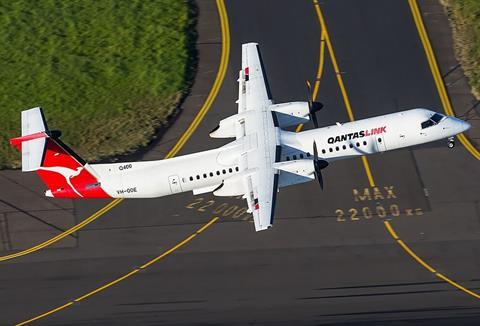Investigators believe habitual behaviour resulted in a De Havilland Dash 8-400 crew’s mis-setting take-off flaps during a departure from a short runway in Queensland last year.
The QantasLink aircraft was heavily-laden, with 67 passengers plus four crew, for the flight out of Horn Island airport, and it was also carrying a high weight of cargo.
Given the circumstances, says the Australian Transport Safety Bureau, the captain repeatedly checked headwind information in order to check that passengers would not have to be offloaded owing to weight restrictions.
Operating to Cairns, the aircraft – weighing 27.8t – was due to depart runway 08 which, with a length of just 1,389m and elevated terrain at the end, presented potential clearance concerns.
“The captain was cognisant of the aircraft performance limitations as the aircraft was carrying a full load,” says the inquiry into the 26 June 2024 incident.
It states that the performance calculations required a 15° flap setting and increased thrust through de-activation of the bleed-air system for take-off.
But the inquiry says the first officer, despite recording the information on a take-off and landing distance card, inadvertently set the flaps to just 5°.

Although the crew conducted standard pre-flight checks and crosschecks, it adds, neither pilot identified the error.
The flaps setting should have been checked through a specific challenge-and-response, but the first officer, who made the flaps call, recalled checking that 5° was set.
This was likely due to “automatic behaviour” and “unconscious habit”, says the inquiry, pointing out that a 5° setting was the most common, and this had been the case for the previous two sectors.
While the Dash 8 accelerated normally, the crew noticed its rotation was slow and the performance was different from prior experience. The aircraft became airborne slightly after the expected rotation speed.
The first officer realised the flap setting was wrong, and told the captain, before lowering the nose in order to increase airspeed. With positive climb maintained, the flight continued to Cairns without further incident.
QantasLink found that the aircraft would have been 2.1t overweight for a 5° flap take-off, with a required take-off distance of 1,680m – longer than the available runway. The error increased the risk of tail-strike and reduced the margin for obstacle clearance.
Investigators state that the carrier subsequently reviewed operating procedures and checklists in order to find ways to reduce erroneous flap selection, and took action to enhance crew training.
























